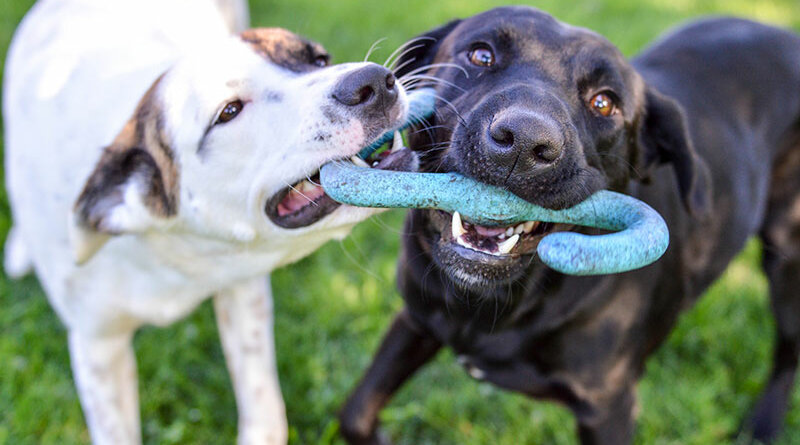Choosing the Right Playmate for Your Dog
Much as we might wish it were so, we can’t just put any two dogs together and expect them to strike up a friendship and share endless delightful play sessions. To connect your dog with the right play buddies, keep compatibility considerations in mind.
No matter how much we may think a pair of dogs would be great together, ultimately, the dogs will decide if they’re going to be BFFs, or even just pals. We can maximize the likelihood that a beautiful friendship will blossom by keeping the following considerations in mind.
1. Do they have compatible play styles? Sure, most dogs love to play, but they may not play the same way. There are dogs who love to play chase, running back and forth with one another endlessly; to engage in rough-and-tumble wrestle play; or play stalking games. Some dogs are much calmer in their play, preferring to gently bat at each other with their paws or bounce around near each other, while others slam into one another, both while running or wrestling in place.
GET THE BARK IN YOUR INBOX!
Sign up for our newsletter and stay in the know.
No one play style is any better than another, but the dogs need to be compatible. They don’t necessarily need to have the same favorite play style as long as there’s one they mutually enjoy. What you don’t want is one dog trying to play chase while the other dog is trying to wrestle. Play sessions only go well if the playmates are trying to play the same game and both are enjoying it.
2. Are their sizes a reasonable match? Dogs certainly don’t have to be the same size to be great friends and play buddies, but there are some advantages to being in the same general range. When dogs are well-matched in size, there is less chance of injuries. It may also make it easier for the dogs to play without one having to take it easy on a much smaller play partner. Dogs who are similar in size can play without having to hold back.
That said, some of the best dog friends in the world are wildly different in size, with the bigger dog being an expert at matching the smaller dog’s level. It’s very fun to watch a tiny dog run over the back of a big dog, or a huge dog play with a small dog while lying down—as long as both dogs are having a fun time and not putting each other at risk.
3. How old are they? Dogs don’t need to be the same age, or even close in age, to have a great time playing together, but age is still a consideration. Compatibility in exuberance, persistence and energy levels is always a plus, and age influences those factors. The biggest issue with dogs of very different ages is that younger dogs often want to play much longer, even after an older dog has had enough. It’s not unusual for an old dog to be excited about playing—for a few minutes, at least.
Pairing a senior dog with a youngster who wants to play morning, noon and night can lead to problems. At a minimum, the young dog may become sad and disappointed, perhaps even tentative about initiating future play with the older dog. Or worse, the younger dog may refuse to give up; this can upset the older dog, who may become aggressive in order to let the pesky, persistent younger dog know that such juvenile rudeness will not be tolerated. Many pairs of dogs of mixed ages get along beautifully, but it’s essential to protect a senior from a youngster who won’t take no for an answer, and to protect a younger dog from an older dog who tells her to knock it off in a potentially scary way.
4. Do both owners have similar views about play? A good play session between dogs isn’t just about the dogs; owners play a role in its success, too. There are decisions to be made when dogs play together and it’s best if the owners of both dogs feel the same way about them. Is it okay if treats are available? How about toys? Are the owners in agreement about what constitutes appropriate play? What sorts of behaviors by the dogs will prompt their people to intervene and require the dogs to take a break? What behaviors will lead to attempts by one of the owners to redirect the dogs to a different activity? Are both owners agreed on the need to pay attention and monitor the play, or do they feel that ignoring the dogs is a better strategy? Or, heaven forbid, are they of the opinion that whatever happens, the dogs need to “work it out themselves”?
5. Does the other dog play nicely? Dogs can play exuberantly and with great energy, but if both dogs are willing participants who are having a good time, that’s a good sign. If, on the other hand, a dog finds the other dog scary or overwhelming, that is not okay. Dogs who are relentless, pushy or rude are not playing nicely, and they do not make the best play buddies. Even if she’s not frightened, it’s sensible to protect a dog from bad-mannered play. Not only can it lead to situations that are not fun, it can also teach a dog that such behavior is an acceptable way to play.
6. Does the other dog have bad habits you don’t want your dog to pick up? As social animals, our dogs do learn from one another, including during play. Like children who act out after spending time with an unruly friend, dogs also pick up bad habits from other dogs. Such contagious behavior can include barking at passersby, running along a fence growling and lunging at a dog on the other side, digging and howling. Sometimes, people are quick to assume that their young dog picked up an unfortunate behavior from a play buddy when in fact, the dog likely developed such behaviors on her own. However, there’s no doubt that dogs can acquire unfortunate habits from other dogs, so choosing play buddies who don’t exhibit these behaviors is a wise idea.
7. Does your dog like the other dog? Is the other dog one your dog is interested in and wants to play with? The heart wants what the heart wants, and one of the best reasons to choose a play buddy for your dog is that your dog loves the other dog. As long as there are no red flags, why not choose to have play dates with the dog that makes your dog the happiest and most eager and enthusiastic to play?
May your dog have many happy play sessions with dogs who are a perfect match. Let the games begin!





